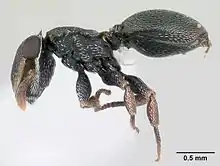| Cephalotes minutus | |
|---|---|
 | |
| Cephalotes minutus worker | |
| Scientific classification | |
| Domain: | Eukaryota |
| Kingdom: | Animalia |
| Phylum: | Arthropoda |
| Class: | Insecta |
| Order: | Hymenoptera |
| Family: | Formicidae |
| Subfamily: | Myrmicinae |
| Genus: | Cephalotes |
| Species: | C. minutus |
| Binomial name | |
| Cephalotes minutus (Fabricius, 1804) | |
Cephalotes minutus is a species of arboreal ant of the genus Cephalotes, characterized by an odd shaped head and the ability to "parachute" by steering their fall if they drop off of the tree they're on. Giving their name also as gliding ants.[1][2] The species is native of a large part of Central and South America, from the Argentinian region of Corrientes in the south, to the Mexican state of Tamaulipas, even to the American state of Texas in the north, making it one of the species with the largest native area of its genus.[3] Their larger and flatter legs, a trait common with other members of the genus Cephalotes, gives them their gliding abilities.[4]
The species was first given a description and a classification in 1804 by Danish entomologist Johan Christian Fabricius, and Cephalotes minutus is part of his classification, which is the first modern classification of insects.
References
- ↑ Latreille, P.A. (1802). Histoire naturelle, generale et particuliere des crustaces et des insectes. Vol. 3. F. Dufart, Paris. 467 pp. PDF
- ↑ Yanoviak, S. P.; Munk, Y.; Dudley, R. (2011). "Evolution and Ecology of Directed Aerial Descent in Arboreal Ants". Integrative and Comparative Biology. 51 (6): 944–956. doi:10.1093/icb/icr006. PMID 21562023.
- ↑ "Species Range Maps". Antmaps.org. Retrieved 27 January 2019.
- ↑ De Andrade, Maria; Urbani, Cesare (1999). Diversity and adaptation in the ant genus Cephalotes, past and present (Hymenoptera, Formicidae). Stuttgarter Beitraege zur Naturkunde Serie B (Geologie und Palaeontologie). pp. 197-211. Retrieved 27 January 2019.
External links
 Media related to Cephalotes minutus at Wikimedia Commons
Media related to Cephalotes minutus at Wikimedia Commons